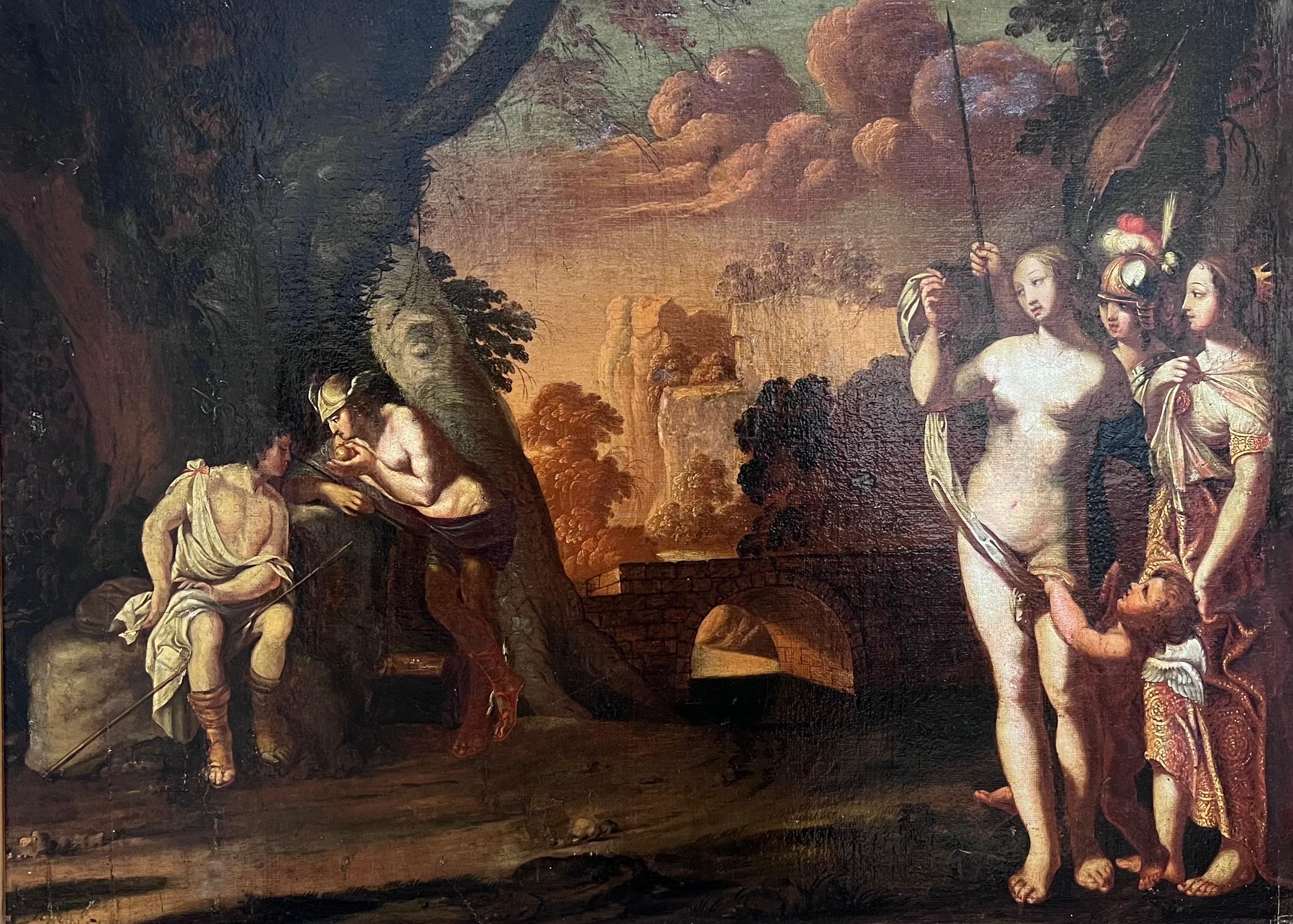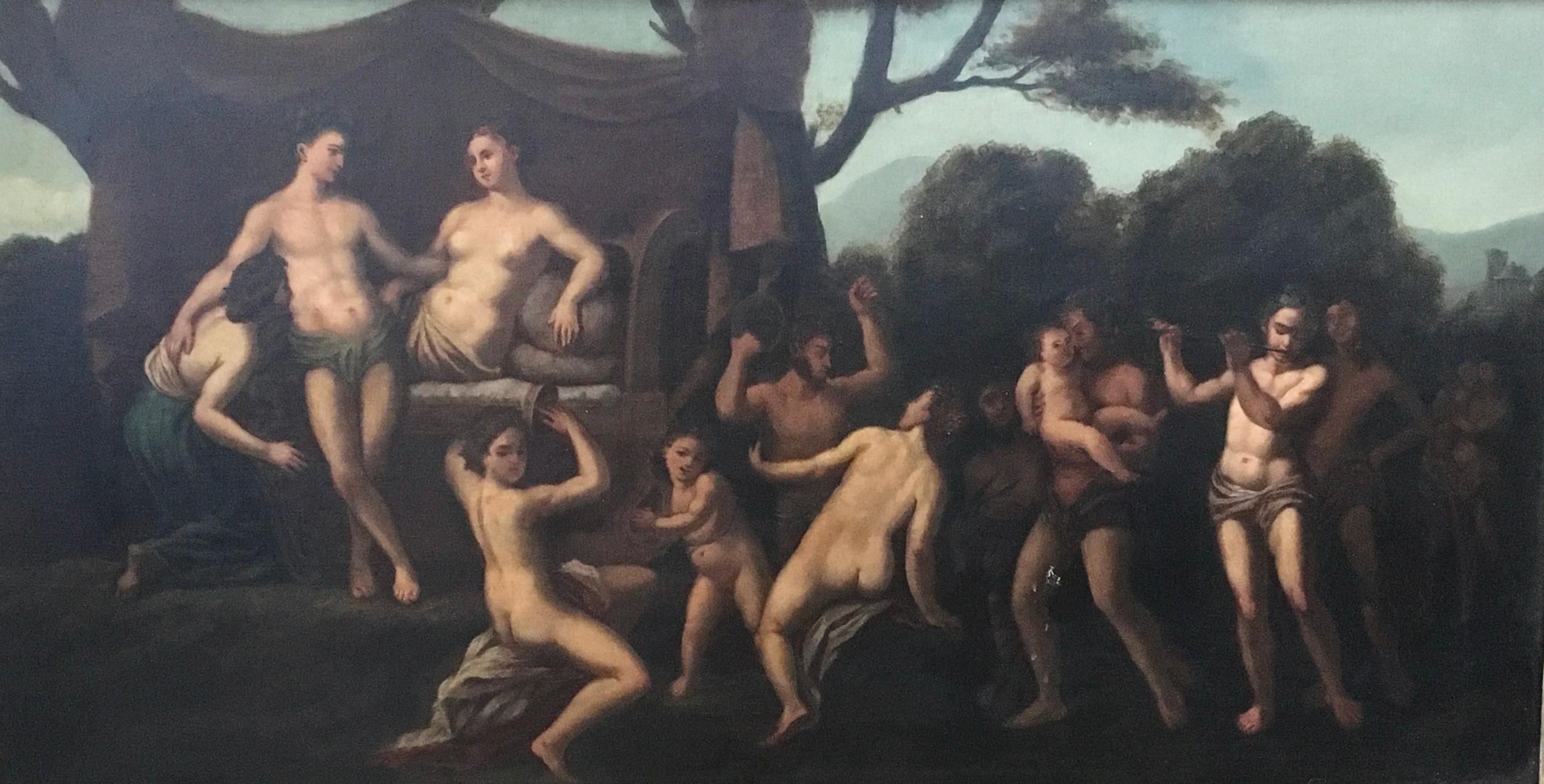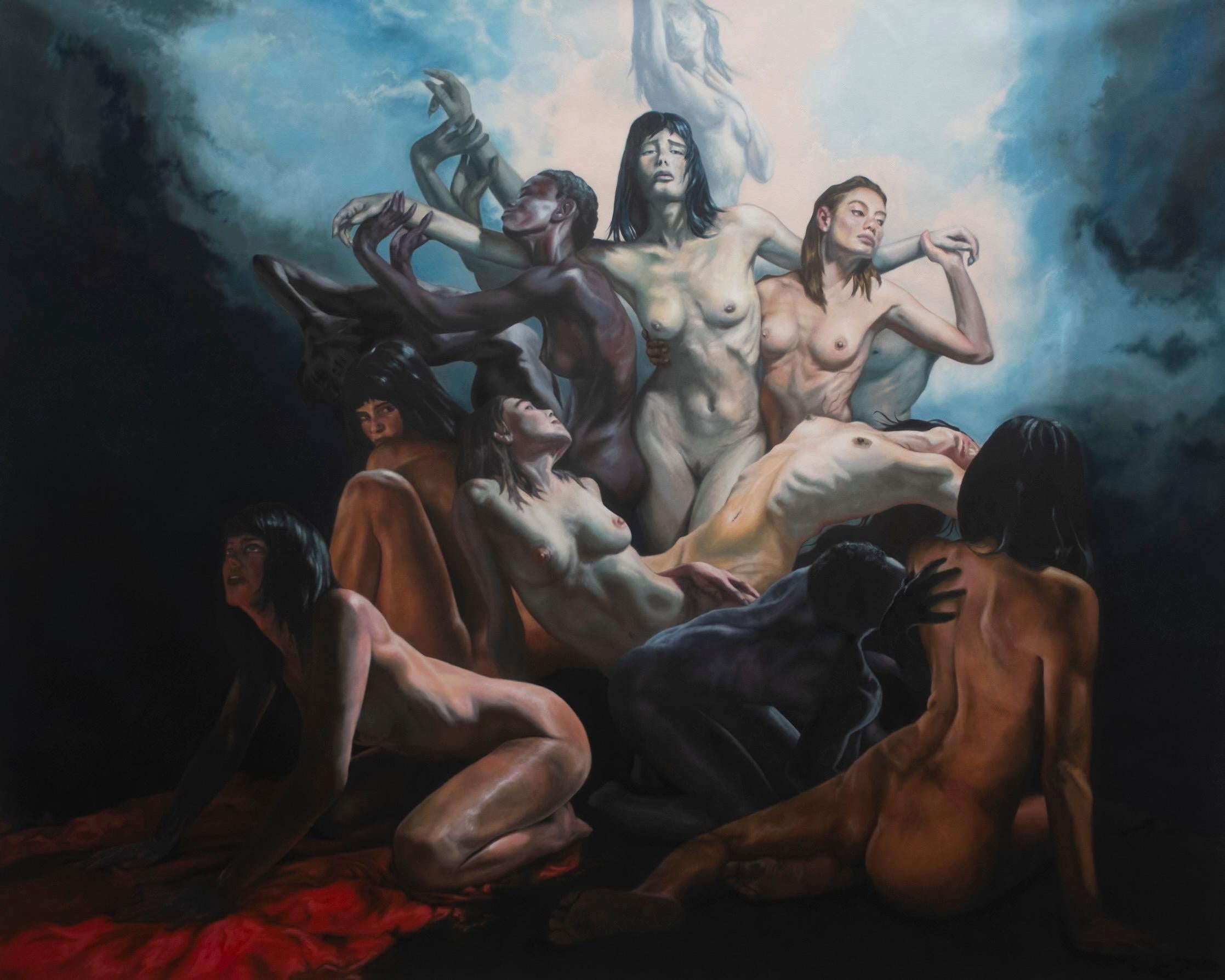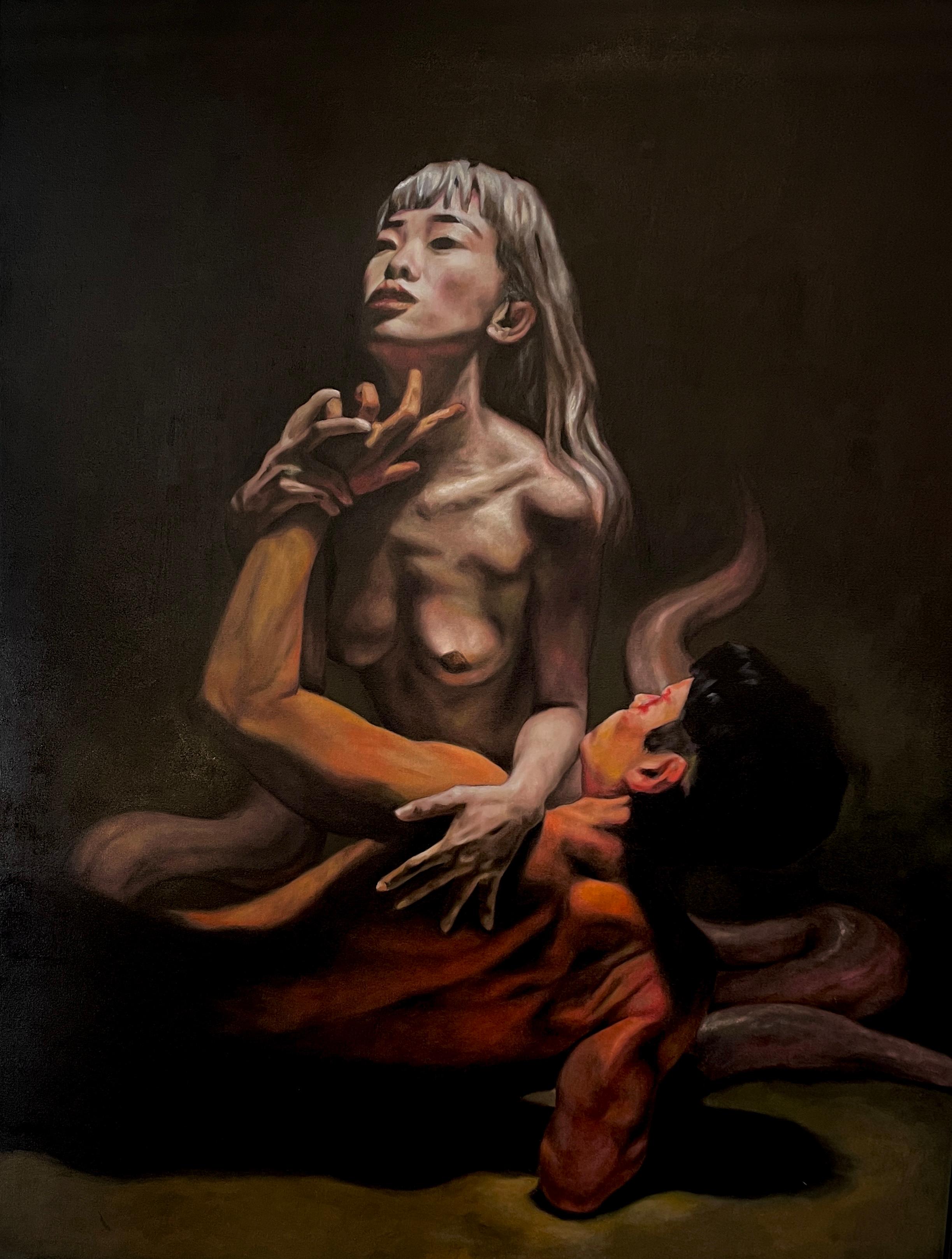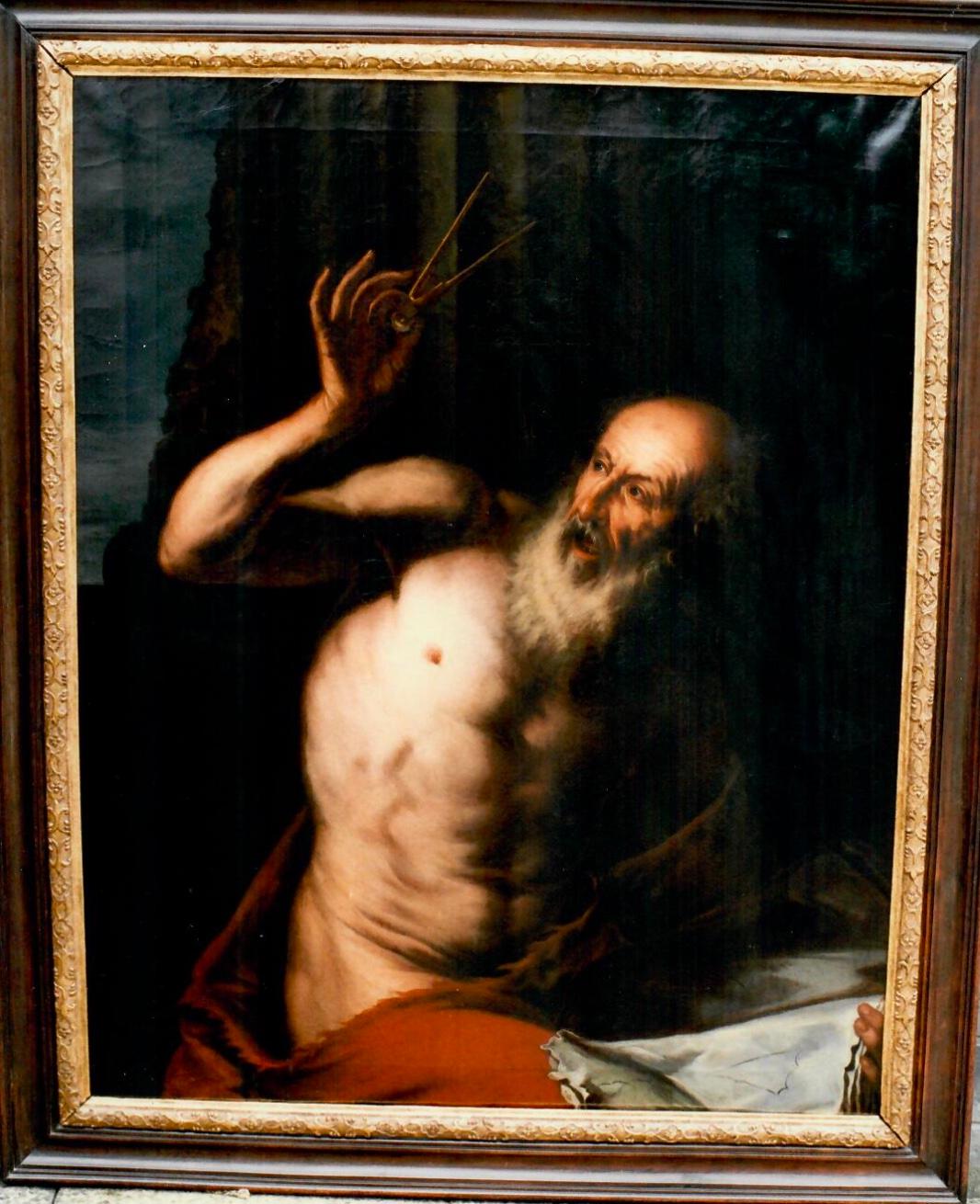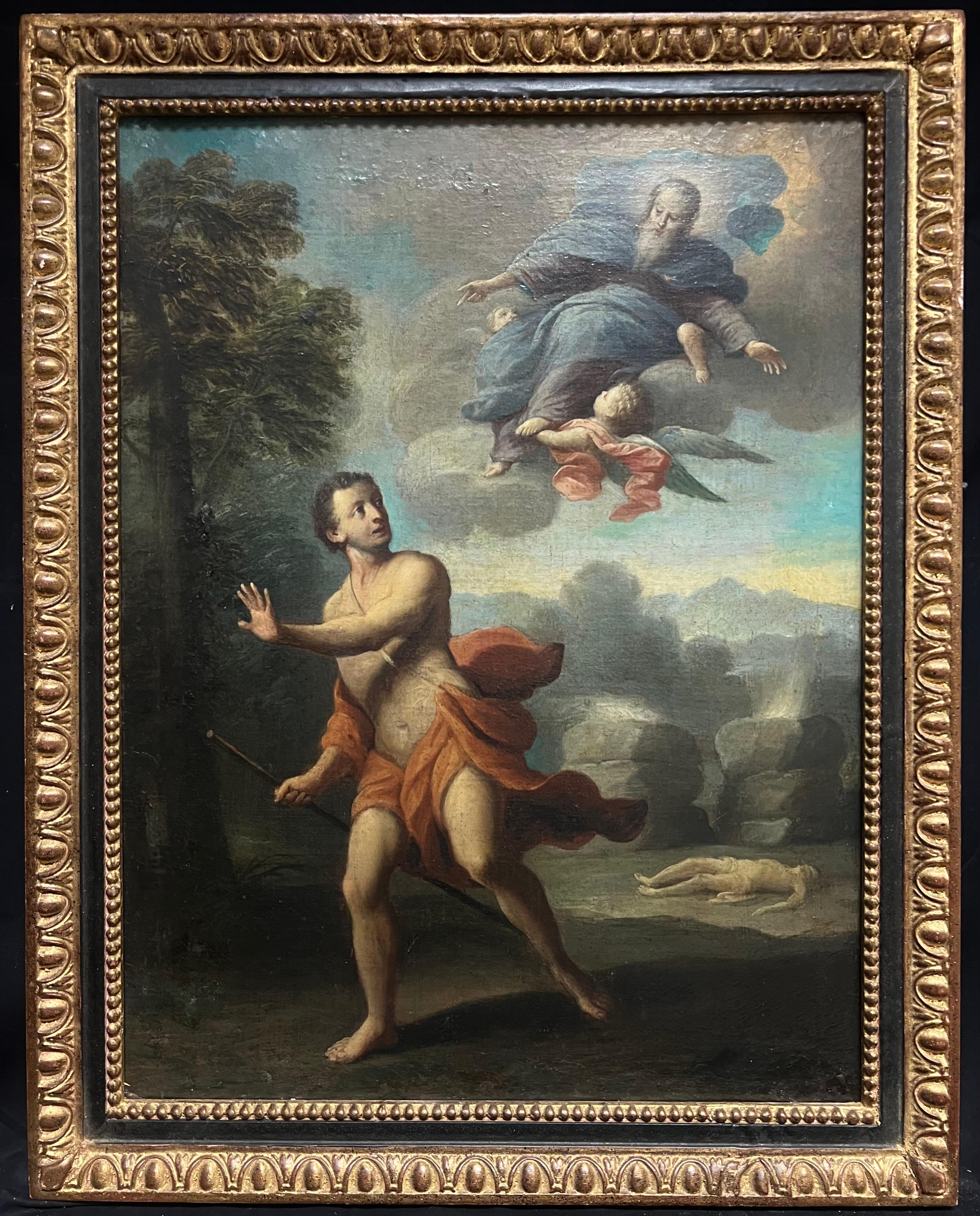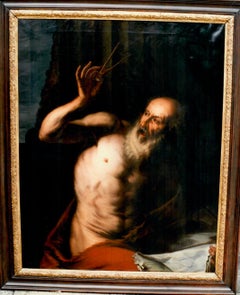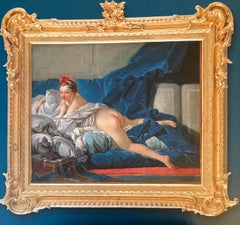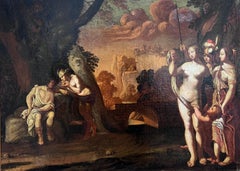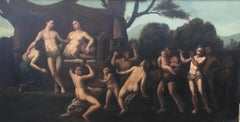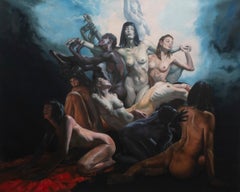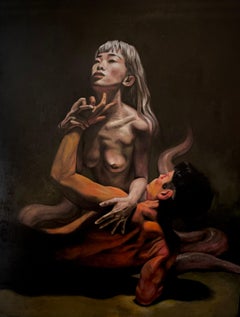Items Similar to Amor Cutting Bow, Parmigianino, Old Master, Mannerism, Prague, Large Painting
Video Loading
Want more images or videos?
Request additional images or videos from the seller
1 of 16
Amor Cutting Bow, Parmigianino, Old Master, Mannerism, Prague, Large Paintingc. 1610
c. 1610
About the Item
Already in the collection of Emperor Rudolf II in the first decade of the 17th century this composition was famous. The original is by Parmigianino and Rudolf's court painter Joseph Heintz the Elder made a copy after Parmigianino's Arch Carving Cupid, painted in 1535. These two paintings hung side by side for a long time in the imperial treasury in Vienna, where they were considered a special sight. Soon there were myths about the paintings, that Heintz had even died out of grief that his copy could never reach the artistry of the original.
The inspiration for this composition possibly goes back to a sculpture that Parmigianino might have seen in 1530 in the Grimani collection in Venice. In fact, Eros/Amor/Cupido stands before us like a painted sculpture. The subject probably goes back to late antique ideas in which Eros, Himeros (desire) and Pothos (longing) form an erotic triad. In the Renaissance it is redefined as heavenly and earthly love. This painting is thus a comment on the difficulty of choosing between these two forms of love.
The present painting is certainly connected to the composition by Heintz and it is another version of this subject by an so far unkown painter. The style clearly shows the influence of the Prague School. Its quality illustrates the style of Mannierism.
It is a very large, decorative piece and it creates a unique atmosphere in an interior.
Amor Cutting His Bow, 17th Century, Old Master, Mannierism, Rudolph II.
- Creation Year:c. 1610
- Dimensions:Height: 55.12 in (140 cm)Width: 34.26 in (87 cm)
- Medium:
- Movement & Style:
- Circle Of:Joseph Heintz (1564 - 1609, Swiss)
- Period:
- Condition:
- Gallery Location:Greven, DE
- Reference Number:1stDibs: LU155027942902
About the Seller
4.8
Vetted Professional Seller
Every seller passes strict standards for authenticity and reliability
Established in 2011
1stDibs seller since 2021
25 sales on 1stDibs
- ShippingRetrieving quote...Shipping from: Greven, Germany
- Return Policy
Authenticity Guarantee
In the unlikely event there’s an issue with an item’s authenticity, contact us within 1 year for a full refund. DetailsMoney-Back Guarantee
If your item is not as described, is damaged in transit, or does not arrive, contact us within 7 days for a full refund. Details24-Hour Cancellation
You have a 24-hour grace period in which to reconsider your purchase, with no questions asked.Vetted Professional Sellers
Our world-class sellers must adhere to strict standards for service and quality, maintaining the integrity of our listings.Price-Match Guarantee
If you find that a seller listed the same item for a lower price elsewhere, we’ll match it.Trusted Global Delivery
Our best-in-class carrier network provides specialized shipping options worldwide, including custom delivery.More From This Seller
View AllEuklid Philosopher, Portrait of a Man, Old Master Painting, Baroque Art
Located in Greven, DE
Impressive Painting of the philosophy Euclid, painted in the Manner of Luca Giordano.
Provenance: Amsterdam, Sotheby's, 21.11.1995, Lot 46
Category
17th Century Baroque Figurative Paintings
Materials
Canvas, Oil
Hercules and Omphale, Old Master Painting, Mannerism, Baroque, Mythology, Prague
Located in Greven, DE
Hercules and Omphale
Oil on panel, 52 x 41 cm
According to legend, Hercules had to make atonement and became a slave to the Lydian queen Omphale. When she found out who her slave was, she married him. Falling for his mistress and made effeminate by the luxury of court life, the former hero allowed himself to become the laughing stock of the court. He dressed in women's clothes, spun wool and did other women's work, whereas Omphale wore his lion's skin and carried a wooden club. When the time of punishment was over, the hero realised his delusion and left Omphale.
So far, the painting could not be clearly assigned to an artist. Nevertheless, it impresses with its fluid and convincing painting, whose colourfulness and conception are reminiscent of the Prague School around Bartholomäus Spranger.
This work follows an engraving and an etching made by Michel Dorigny in 1643 after a design by Simon Vouet. It shows the same scene but the print differs in minor details from the present painting (see e.g. the head of the lion) and the treatment of the faces seems to be painted more detailed and refined.
So far there is no painting...
Category
17th Century Baroque Figurative Paintings
Materials
Oil, Panel
Rococo Painting, The Brunette Odalisque, Nude Woman, Studio of Francois Boucher
By François Boucher
Located in Greven, DE
A voluptuous woman lies prone on a divan, bearing her backside and turning her head flirtatiously to the viewer, though averting her eyes slightly, as if to maintain a coy demeanor. Surrounded by lush fabrics of deep blues, the creamy tones of her skin and dressing gown are thrown in sharp contrast, making the figure glow luminously. The whole painting is ordered by folds - of flesh, of fabric, of cushions, of the rug - inviting the viewer's eye to look closely across the topography of the canvas.
One of Boucher's cabinet paintings (that is, paintings made for private collectors rather than official exhibition at the Salon), the open eroticism of this work invites a voyeuristic gaze. Although it was created for a private audience, it was later displayed at the Salon of 1767, where the critic Denis Diderot found it shocking and lascivious. Nonetheless, Boucher would later paint another iteration of this reclining pose, this time using Marie-Louise O'Murphy, a favorite mistress of King Louis XV, as his model, suggesting that the provocative composition was a stock figure for Boucher's private commissions.
"The Brunette Odalisque" (French: L'Odalisque or l'Odalisque brune) is a painting of c. 1745 by François Boucher, now in the Louvre in Paris. He later produced two other works in the odalisque genre, both known as "The Blonde Odalisque".
The present painting is another version of Bouchers painting which differs in minor details. The quality of the paint is very fine and the whole technique and style allows a dating to c. 1750. As Boucher's Painting was very famous there were several copies and versions which were made by his studio. The present painting can be attributed to the close circle of Boucher.
The Painting is framed in a golden frame which was built in the Rococo style in c. 1990.
Both the title of Boucher's painting and the objects found in the interior fix the subject as an odalisque, a concubine within the harem of the Ottoman sultan. The sumptuous textiles and exotic, decorative objects suggest early traces of Orientalism, although the figure appears European. Odalisque paintings...
Category
18th Century Rococo Nude Paintings
Materials
Canvas, Oil
Fenzoni, Painting AND preparatorial Drawing, John the Baptist, Italy Renaissance
By Ferrau Fenzoni
Located in Greven, DE
The painting and the preparatory drawing are offered together.
Provenance
Private collection, Germany, Trier, c. 1980- 2013
Saint John the Baptist
Brown ink and wash over red chalk on oatmeal paper
31 x 20.5 cm
Inscribed: „Ferrau Fenzonio da Faenza invt. esque … imp. da Fran. Villamena …“.
bears the collector's mark of Henry Scipio Reitlinger (1882-1950; Lugt 2274a) on a tiny label glued to the verso
On the reverse is a partial drawing of a Pieta, pricked for transfer.
Provenance
New York, Doyle, 14. October 2015, No. 6
The painting and the preparatory drawing resemble the composition of an engraving after Ferraù Fenzoni by Francesco Villamena. Drawing, engraving and painting are almost identical, except for minor differences. Even the measurements nearly correspond: painting (32 x 25,5 cm), drawing (30 x 20,5 cm), engraving (31,1 x 23,5 cm).
Dr. Guiseppe Scavizzi confirmed the attribution of the present panting to Fenzoni and he dates it to c. 1590.
The inscription on the drawing reads “Ferrau Fenzonio da Faenza invt. esque. . . imp. da Fran: Villamena . . .”. The engraving’s inscription also lists place and date “Ferra Fensionius inventor/F. Villamoena sculpsit Rome/Aspectu fruitur… antra puer/cum Privilegio… 1613”.
Interestingly, the engraving is not mirrored as it is in most printing processes. Painting, drawing and engraving are not reversed but the same. It is remarkable to note that there are further paintings by Fenzoni which were engraved in the same order and not reverted. They also show strong parallels regarding the compositions and the measurements (see for example “Deposition of Christ” ).
Ferraù Fenzoni was an Italian painter mainly active in Todi. He is also called Il Faenzone after his birthplace (Faenza). He apprenticed in Rome during the papacy of Gregory XIII and contributed to numerous fresco cycles under pope Sixtus V, such as the Loggia della Benedizioni in the Lateran Palace, the frescoes on the walls and vaults of the Scala Santa of the adjacent Basilica of San Giovanni in Laterano, and the decoration in the Sistine library. His expressive canvases straddle the styles of Mannerism and Baroque. In 1594, he moved to Todi. A “Last Judgement” by him is housed in the cathedral of Todi. He returned to Faenza in 1599, where he decorated chapels in the cathedral from 1612 to 1616. In 1622, he completed a “Deposition”, now in the local Pinacoteca. In 1640, Fenzoni was named “cavaliere dello speron d’oro” by Cardinal Colonna and, on 25th April 1634, he was nominated vicar and “castellano of Granarolo”.
Fenzoni‘s style is characterized by a mixture of the Mannerism of the Northern Netherlands and the Italian Baroque.
Saint John the Baptist, Old Master, 17th Century, By Fenzoni, Religious Scene, Rome Art...
Category
16th Century Mannerist Figurative Paintings
Materials
Canvas, Oil, Handmade Paper
Ferrau FenzoniFenzoni, Painting AND preparatorial Drawing, John the Baptist, Italy Renaissance, 1590
$27,833 Sale Price
25% Off
Road to Emmaus in a Landscape, Pilgrims, Gillis de Hondecoeter, Old Master
Located in Greven, DE
The painting "The Road to Emmaus in a Landscape" by Gillis de Hondecoeter is a masterful example of early 17th-century Dutch landscape painting. The sce...
Category
17th Century Baroque Figurative Paintings
Materials
Oil, Canvas
$13,568 Sale Price
35% Off
Baroque Italian Old Master, Madonna, Child, Angels, Oval, Marratta, Christmas
By Workshop Of Carlo Maratta
Located in Greven, DE
Religious Painting, depicting Madonna and the Child, surrounded by Angels by the Circle of Carlo Maratta (Maratti). This painting is wonderful example of...
Category
18th Century Baroque Figurative Paintings
Materials
Canvas, Oil
$18,555 Sale Price
20% Off
You May Also Like
Large 16th Century Old Master Oil Painting The Judgement of Paris Mythological
Located in Cirencester, Gloucestershire
The Judgement of Paris
Fontainebleau School, circa 1580 *see notes below
oil painting on canvas, framed
framed: 30 x 40 inches
canvas: 27 x 37 inches
Provenance: private collection, ...
Category
16th Century Mannerist Figurative Paintings
Materials
Oil
Late 18th Century Italian Baroque Allegorical Mythical Nudes VIRTUE OF VICE o/c
Located in Rancho Santa Fe, CA
This painting is likely to be from the late 18th or early 19th century, and is likely inspired by Antonio Correggio's "Virtue of Vice" circa 1531. Frame dimensions: 30 x 49 inches. This painting has been in a private California collection for over 40 years. It was acquired from a high end antique...
Category
19th Century Baroque Nude Paintings
Materials
Canvas, Oil
'Children of Pride' by Rizaldy - Epic Contemporary Baroque Figurative Nude
Located in Carmel, CA
Rizaldy Celi Jr. (Filipino-Vietnamese, American, born 1983)
"Children of Pride" 2024
Oil paint, Varnish, Canvas, Stretcher Bars
The artist signed the back of the painting.
"Children...
Category
2010s Baroque Figurative Paintings
Materials
Canvas, Oil, Stretcher Bars, Varnish
"Undeniable" by Rizaldy - Contemporary Disrupted Realism - Figurative Nude
Located in Carmel, CA
Rizaldy Celi Jr. (Filipino-Vietnamese, American, born 1983)
"Undeniable" 2024
Oil paint, Varnish, Canvas, Stretcher bars
The artist signed the back of the painting.
'Undeniable' by ...
Category
2010s Baroque Figurative Paintings
Materials
Canvas, Oil, Varnish, Stretcher Bars
French 17th Century Baroque Period Old Master Oil Painting Archery Figure
Located in Cirencester, Gloucestershire
Baroque Landscape with Figures
French School, 17th century
oil on canvas, framed
Framed: 29.5 x 23.5 inches
Canvas : 25.5 x 19 inches
Provenance: private collection, France
Condition...
Category
17th Century Baroque Figurative Paintings
Materials
Oil
Very Fine 18th Century Italian Oil Painting Nude Figures in Classical Landscape
Located in Cirencester, Gloucestershire
Classical Figures in Ancient Landscape
Italian School, 18th century
oil on panel,
painting: 9 x 12 inches
provenance: private collection, Paris
condition: very good and sound condition
Category
18th Century Baroque Figurative Paintings
Materials
Oil
Recently Viewed
View AllMore Ways To Browse
Frame Bow
Original Antique Large Painting
Antique Long Bows
Renaissance 17th Century Painting
Cupid Painting
Amor Sculpture
Copy Antique Oil
Antique Old Master Very Large Frame
Antique Paintings Of Cupid
Antique Erotic Oil Painting
Nude Ballet
Semi Nude
Alexander Young
Andal Idol
Antique Print Venice
Baltimore Sculpture
Human Bone
Men Cross
